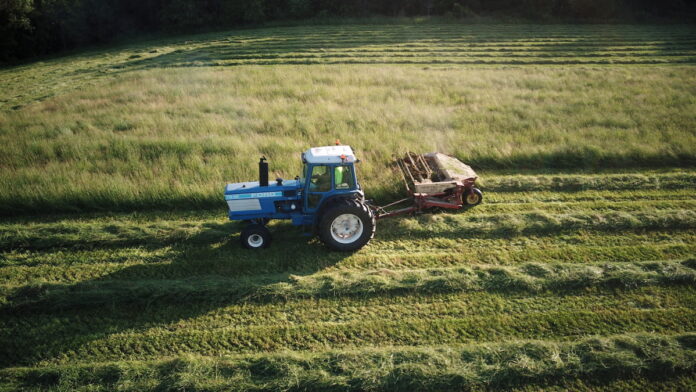
Mother nature has been at it again, hardly giving us enough days to make silage or balelage let alone dry hay. There is a risk of pop-up showers every afternoon it seems like. The ground is also wet so the forage laying against the ground does not dry very well. These conditions are very dangerous for hay harvest since wet hay does not just rot it may also burn. Hay fires are caused when bacteria in wet hay create so much heat that the hay spontaneously combusts in the presence of oxygen. At over 20% moisture, mesophilic bacteria release heat, causing temperature to rise between 130 F to 140 F with temperature staying high for up to 40 days. As temperatures rise thermophilic bacteria can take off in your hay and raise the temperature into the fire danger zone of over 175 F.
Assessing your risk
If hay was baled between 15-20% moister and acid preservatives were used there is still potential for a hay fire but not as great as on non-treated hay. Having a moisture tester on your baler can help you know the variability across your field in moisture and when to use hay preservatives. Without a moisture tester if you find darker green damp spots occasionally or humidity is high be sure to monitor for heating. Most propionic acid-based products are effective if applied at the correct rates at inhibiting bacteria growth in hay up to 25% moisture, with variable effectiveness at 25-30% moisture.
Temperature assessment
125 F – No Action needed.
150 F – Hay is entering the danger zone, check temperatures twice per day. Disassemble haystacks moving bales outside to allow air circulation to cool the hay.
160F – Hay has reached the danger zone. Carefully check hay temperature every few hours. Disassemble stacked hay to promote air circulation to cool hay be very careful of even hotter spots. Have a tank of water present while unstacking.
175-190 F – Hot spots or fire pockets are likely. Alert fire service to the possible hay fire incident. Close barns to minimize air movement around the hay. With the assistance of the fire service, remove hot hay. Be aware that bales may burst into flames, so keep tractors wet so the tractor does not catch fire.
200 F – Fire is present within the haystack near the temperature probe. With the assistance of the fire service, remove hot hay. If possible, inject water into the hot spot to cool hay before moving. Most likely a fire will occur, keep tractors wet and fire hose lines charged in the barn and along the route to where bales will be stacked.
Monitoring the haystack
There are a couple of options available to monitor hay temperature. One uses technology like the cables that can be used to monitor the temperature in stored grain. There are a couple of companies that produce cables that would be placed between bales in a stack or monitoring probes that are placed in bales and use radio frequency to transmit signals to the web.
If you believe that you are at risk for hay heating, monitoring temperature is critical. It should be done daily until temperatures stabilize in the safe zone or reach 150 F when monitoring needs to be increased to twice daily. This can be done with technology or manual temperature probes. When monitoring hay temperature, be very cautious, hot hay can burn within the stack and cause cavities underneath that you can fall into. Use planks to spread out your weight while walking on the stack and have a harness system attached to the ceiling in case you fall into a burned-out cavity. Also, work in pairs with someone on the ground within voice range to assist you if you find yourself in a bad situation. Temperature monitoring should continue for possibly six weeks until values stabilize in the safe zone.
Temperature monitoring depends on the stack size but should be taken close to the center of the stack. In larger stacks ideally, this is 8 feet down in the stack. Any time temperatures are above 175 F, hay shouldn’t be removed from the barn until the local fire department is present because you are at risk for fire. Once the fire department is present, hay should be carefully removed with charged fire hoses ready if spontaneous combustion occurs.












